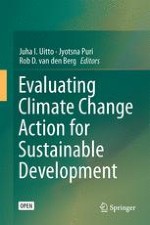Open Access 2017 | Open Access | Buch

Evaluating Climate Change Action for Sustainable Development
herausgegeben von: Dr. Juha I. Uitto, Dr. Jyotsna Puri, Prof. Rob D. van den Berg
Open Access 2017 | Open Access | Buch

herausgegeben von: Dr. Juha I. Uitto, Dr. Jyotsna Puri, Prof. Rob D. van den Berg
This authoritative book presents the ever progressing state of the art in evaluating climate change strategies and action. It builds upon a selection of relevant and practical papers and presentations given at the 2nd International Conference on Evaluating Climate Change and Development held in Washington DC in 2014 and includes perspectives from independent evaluations of the major international organisations supporting climate action in developing countries, such as the Global Environment Facility.
The first section of the book sets the stage and provides an overview of independent evaluations, carried out by multilateral development banks and development organisations. Important topics include how policies and organisations aim to achieve impact and how this is measured, whether climate change is mainstreamed into other development programs, and whether operations are meeting the urgency of climate change challenges.
The following sections focus on evaluation of climate change projects and policies as they link to development, from the perspective of international organisations, NGO’s, multilateral and bilateral aid agencies, and academia. The authors share methodologies or approaches used to better understand problems and assess interventions, strategies and policies. They also share challenges encountered, what was done to solve these and lessons learned from evaluations. Collectively, the authors illustrate the importance of evaluation in providing evidence to guide policy change to informed decision-making.